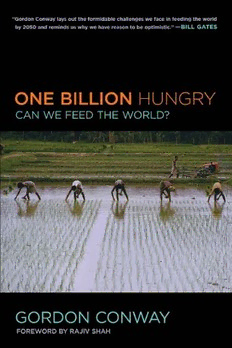
One Billion Hungry: Can We Feed the World? PDF
Preview One Billion Hungry: Can We Feed the World?
One Billion Hungry One Billion Hungry Can We Feed the World? GORDON CONWAY with Katy Wilson Foreword by Rajiv Shah Published with the support of Agriculture for Impact, Imperial College, London Comstock Publishing Associates, a division of Cornell University Press | Ithaca and London This publication is based on research funded in part by the Bill & Melinda Gates Foundation. The fi ndings and conclusions contained within are those of the authors and do not necessarily refl ect positions or policies of the Bill & Melinda Gates Foundation. Copyright © 2012 by Cornell University All rights reserved. Except for brief quotations in a review, this book, or parts thereof, must not be reproduced in any form without permission in writing from the publisher. For information, address Cornell University Press, Sage House, 512 East State Street, Ithaca, New York 14850. First published 2012 by Cornell University Press First printing, Cornell Paperbacks, 2012 Printed in the United States of America and the United Kingdom Library of Congress Cataloging- in- Publication Data Conway, Gordon. One billion hungry : can we feed the world? / Gordon Conway with Katy Wilson ; foreword by Rajiv Shah. p. cm. “Published with the support of Agriculture for Impact, Imperial College, London.” Includes bibliographical references and index. ISBN 978- 0- 8014-5 133- 1 (cloth : alk. paper) ISBN 978- 0- 8014-7 802- 4 (pbk. : alk. paper) 1. Agricultural innovations— Developing countries. 2. Green Revolution— Developing countries. 3. Food supply— Developing countries. 4. Food security— Developing countries. I. Wilson, Katy. II. Conway, Gordon. Doubly green revolution. III. Title. S494.5.I5C663 2012 338.1'6091724—dc23 2012014403 Cornell University Press strives to use environmentally responsible suppliers and materials to the fullest extent possible in the publishing of its books. Such materials include vegetable- based, low- VOC inks and acid- free papers that are recycled, totally chlorine- free, or partly composed of nonwood fi bers. For further information, visit our website at www .cornellpress .cornell .edu . Cloth printing 10 9 8 7 6 5 4 3 2 1 Paperback printing 10 9 8 7 6 5 4 3 2 1 To the memory of Cyril and Thelma Conway Contents Foreword by Rajiv Shah ix Ac know ledg ments xi Editorial Note xv Part I 1 Acute and Chronic Crises 3 2 What Is Hunger? 21 3 The Green Revolution 41 4 The Po liti cal Economy of Food Security 63 Part II 5 A Doubly Green Revolution 85 6 Sustainable Intensifi cation 103 7 Appropriate Technology 125 8 Creating Markets 143 Part III 9 Designer Crops 167 10 The Livestock Revolution 187 11 Farmers as Innovators 207 Part IV 12 Controlling Pests 227 13 Rooted in the Soil 246 14 Sustained by Water 268 15 Adapting to Climate Change 286 16 Reducing Greenh ouse Gases 306 17 Conclusion: Can We Feed the World? 329 References 349 Index 429 Foreword by Rajiv Shah Administrator of the United States Agency for International Development By the late 1990s, global food security had mostly fallen off the world’s agenda. The success of the Green Revolution had helped hundreds of millions of people in Latin America and Asia avoid a life of extreme hunger and poverty. Governments— developed and developing alike—a ssumed this success would spread and cut their investments in agriculture, allowing them to turn their attention elsewhere. But while many had lost sight of the importance of agricultural development, Gordon Conway stayed focused. In his book, A Doubly Green Revolution, published in 1997, Gordon issued a pressing call for the development community to recommit to the goals of fi ghting hunger and malnutrition around the world. Gordon argued that the lasting elimination of hunger required us to do more than transform the production of food—t he hallmark achievement of the Green Revo- lution. We also had to help smallholder farmers build resilience to natural disasters and climate change, use advances in science and technology to boost yields, and part- ner with the private sector to get those crops to market. Thanks to Gordon’s leader- ship, the world is once again delivering a global commitment to strengthening food security. In 2009, President Obama established a global food security initiative called Feed the Future. Spearheaded by the U.S. Agency for International Development, Feed the Future helps countries develop productive agriculture sectors so they can feed them- selves and transform their economies over the long term. In partnership with local and international private companies, the global initiative supports country- led plans to focus investment in regions most likely to fl ourish, and in crop and livestock sys- tems with the greatest chance of fi ghting poverty and malnutrition. These efforts are more important now than ever before. In the Horn of Africa, the worst drought in 60 years put more than 13.3 million people in the path of hunger and disease during 2011. In Somalia, where dec ades of civil war and disorder have contributed to the complete breakdown of governance, drought led to a famine that threatened the security and economic growth of the entire region. In coordination with humanitarian assistance, long-t erm approaches to strengthen resilience— for example, safety nets, frontline health programs, and vaccination campaigns— helped mitigate the worst of the drought impacts across the Horn. But ix
